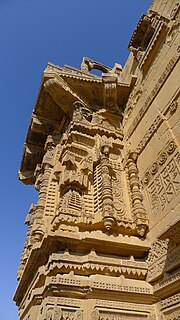This page is based on this
Wikipedia article Text is available under the
CC BY-SA 4.0 license; additional terms may apply.
Images, videos and audio are available under their respective licenses.

The Indus River is one of the longest rivers in Asia. Originating in the Tibetan Plateau in the vicinity of Lake Manasarovar, the river runs a course through the Ladakh region of Jammu and Kashmir, towards the Gilgit-Baltistan region of Pakistan and the Hindukush ranges, and then flows in a southerly direction along the entire length of Pakistan to merge into the Arabian Sea near the port city of Karachi in Sindh. It is the longest river and national river of Pakistan.

Sindh is one of the four provinces of Pakistan, in the southeast of the country, and the historical home of the Sindhi people. Sindh is the third largest province of Pakistan by area, and second largest province by population after Punjab. Sindh is bordered by Balochistan province to the west, and Punjab province to the north. Sindh also borders the Indian states of Gujarat and Rajasthan to the east, and Arabian Sea to the south. Sindh's landscape consists mostly of alluvial plains flanking the Indus River, the Thar desert in the eastern portion of the province closest to the border with India, and the Kirthar Mountains in the western part of Sindh.
Sindhis are an Indo-Aryan ethno-linguistic group who speak the Sindhi language and are native to the Sindh province of Pakistan, which was previously a part of pre-partition British India. After the partition of India in 1947, most Sindhi Hindus and Sindhi Sikhs migrated to India and other parts of the world. Today, Sindhis are both in India and Pakistan. Indian Sindhis are predominantly Hindu, while Pakistani Sindhis are predominantly Muslim.
Muslim Rajputs or Musulman Rajputs, are patrilineal descendants of Rajputs of Northern regions of the Indian subcontinent who are followers of Islam. Today, Muslim Rajputs can be found in Northern India and some parts of Pakistan. They are further divided into different clans.
The Palijo / Palejo / Paleejo / Palija / Paleja / Paleeja is a Sindhi tribe / Community of Sindh province, Pakistan. Palijo / Palejo / Paleejo / Palija / Paleja / Paleeja is a Sammat tribe. During the Talpur dynasty and before, this tribe held lands on the banks of the Indus River when that area was under official administration of the Palijo tribe and was called Palijar'pargana, ranging from Choriya Jagir, now in Tando Muhammad Khan District, to Pinyari Phat, in Sujawal District.
The Mallaah are the aboriginal traditional boatmen and fishermen tribes or communities of North India, East India, Northeastern India and Pakistan. A significant number of Mallah are also found in Nepal and Bangladesh. In the Indian state of Bihar, the term Nishad includes the Mallah and refers to communities whose traditional occupation centred on rivers.

Jám Nizámuddín II, also known as Jam Nizam al-Din or Jám Nindó, was the Rajput Sultan of Sindh between 1461 and 1508 CE. He was the most famous ruler of the Samma dynasty, which ruled Sindh, parts of Punjab and Balochistan from 1351 to 1551 CE. His capital was Thatta in modern-day southern Pakistan. The Samma dynasty reached the height of its power during the reign of Nizamuddin, who is still recalled as a hero, and whose rule is considered the golden-age of Sindh.
Ranghar, are a Muslim ethnic group, which is found in Sindh and Punjab provinces of Pakistan and Haryana, Delhi and Uttar Pradesh states of India.
Sindhi names are given names and surnames used among Sindhis in Pakistan, India, and the Sindhi diaspora.

The Kamangar is a Muslim community, found in North India, Dist. Chiniot, South Punjab, North Sindh and South Khyber Pakhtunkhwa Pakistan.
Thathai Bhatias is a Rajput clan settled in India. This clan migrated to India from the Thatta District, Sindh after independence of Pakistan in 1947.

Pakistan is home to many archaeological sites dating from Lower Paleolithic period to Mughal empire. The earliest known archaeological findings belong to the Soanian culture from the Soan Valley, near modern-day Islamabad. Soan Valley culture is considered as the best known Palaeolithic culture of Central Asia.
Mehrgarh in Balochistan is one of the most important Neolithic sites dating from 7000 BCE to 2000 BCE. The Mehrgarh culture was amongst the first culture in the world to establish agriculture and livestock and live in villages. Mehrgarh civilization lasted for 5000 years till 2000 BCE after which people migrated to other areas, possibly Harappa and Mohenjo-daro. Harappa and Mohenjo-daro are the best known sites from the Indus Valley civilization.

Banbhore Division, also known as "Thatta Division" or "Bhambore Division", is the sixth administrative division of Sindh as announced by the People's Party's Sindh Government. The name of division is derived from the ancient city of Banbhore. The planned capital of this division is the city of Thatta. In addition to Thatta District itself, plans exist to incorporate the districts of Sujawal and Badin into Banbhore Division; prior to this change, all three of these districts were included in the Hyderabad Division. Sindhi nationalists appreciated this change as they believe it will improve the governance and infrastructure development of region. The Sindh Government also allocated a budget of 11 billion rupees for the development of Banbhore Division.
Bholari railway station is located in Bholari village, Thatta district of Sindh province of the Pakistan.
Braudabad railway station is located in Braudabad village, Thatta district of Sindh province, Pakistan.
Jhimpir railway station is located at Jhimpir village, Thatta district of Sindh province, Pakistan. There is also Pakistan's first wind power plant Jhimpir Wind Power Plant. Jhimpir is 114 km (71 mi) away from Karachi.









